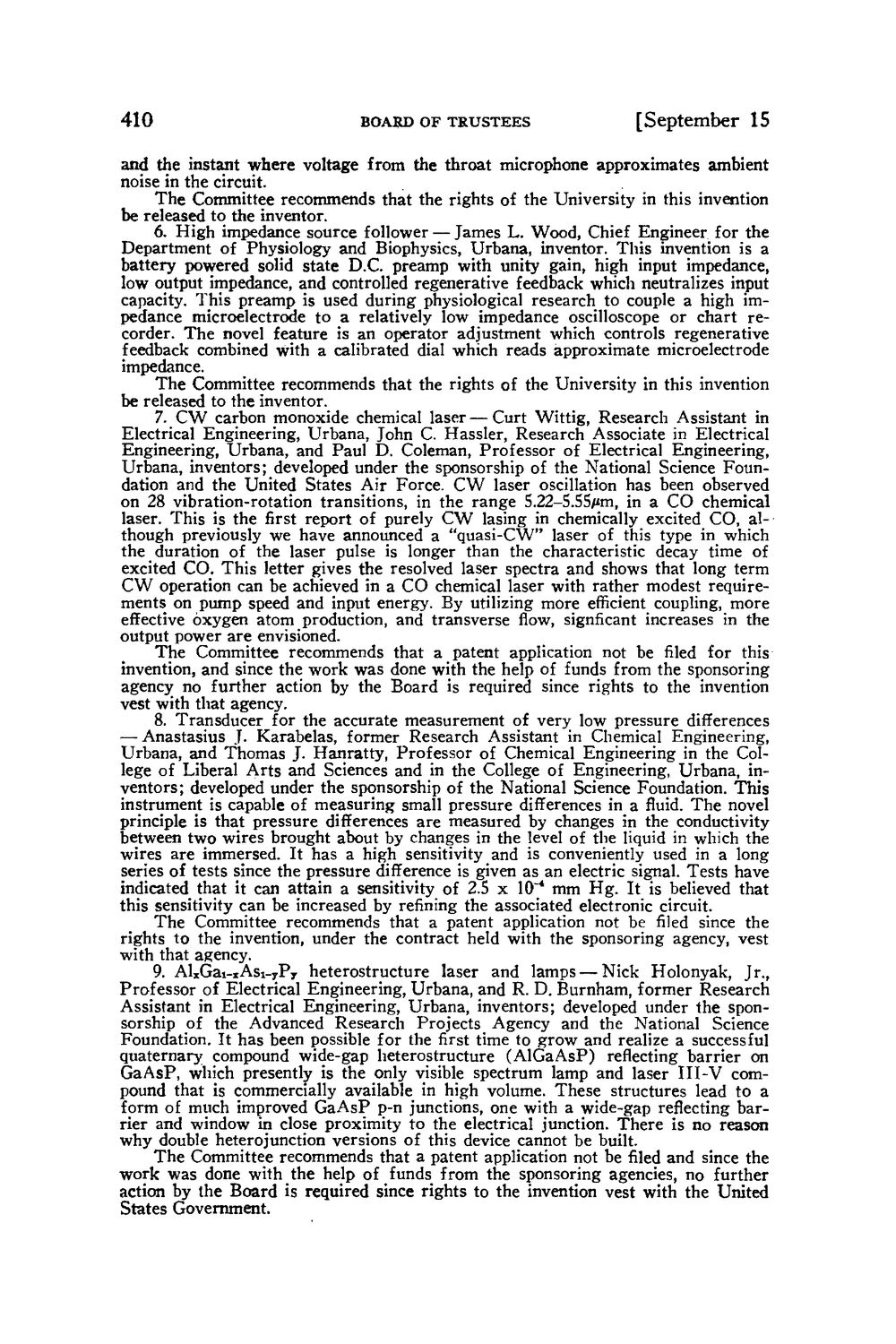| |
| |
Caption: Board of Trustees Minutes - 1972
This is a reduced-resolution page image for fast online browsing.

EXTRACTED TEXT FROM PAGE:
410 BOARD OF TRUSTEES [September 15 and the instant where voltage from the throat microphone approximates ambient noise in the circuit. T h e Committee recommends that the rights of the University in this invention be released to the inventor. 6. High impedance source follower — James L. Wood, Chief Engineer for the Department of Physiology and Biophysics, Urbana, inventor. This invention is a battery powered solid state D.C. preamp with unity gain, high input impedance, low output impedance, and controlled regenerative feedback which neutralizes input capacity. This preamp is used during physiological research to couple a high impedance microelectrode to a relatively low impedance oscilloscope or chart recorder. T h e novel feature is an operator adjustment which controls regenerative feedback combined with a calibrated dial which reads approximate microelectrode impedance. T h e Committee recommends that the rights of the University in this invention be released to the inventor. 7. C W carbon monoxide chemical laser — Curt Wittig, Research Assistant in Electrical Engineering, Urbana, John C. Hassler, Research Associate in Electrical Engineering, Urbana, and Paul D. Coleman, Professor of Electrical Engineering, Urbana, inventors; developed under the sponsorship of the National Science Foundation and the United States Air Force. C W laser oscillation has been observed on 28 vibration-rotation transitions, in the range 5.22-5.55/tfn, in a CO chemical laser. This is the first report of purely C W lasing in chemically excited CO, although previously we have announced a "quasi-CW" laser of this type in which the duration of the laser pulse is longer than the characteristic decay time of excited CO. This letter gives the resolved laser spectra and shows that long term C W operation can be achieved in a CO chemical laser with rather modest requirements on pump speed and input energy. By utilizing more efficient coupling, more effective oxygen atom production, and transverse flow, signficant increases in the output power are envisioned. T h e Committee recommends that a patent application not be filed for this invention, and since the work was done with the help of funds from the sponsoring agency no further action by the Board is required since rights to the invention vest with that agency. 8. Transducer for the accurate measurement of very low pressure differences — Anastasius J. Karabelas, former Research Assistant in Chemical Engineering, Urbana, and Thomas J. Hanratty, Professor of Chemical Engineering in the College of Liberal Arts and Sciences and in the College of Engineering, Urbana, inventors; developed under the sponsorship of the National Science Foundation. This instrument is capable of measuring small pressure differences in a fluid. The novel principle is that pressure differences are measured by changes in the conductivity between two wires brought about by changes in the level of the liquid in which the wires are immersed. It has a high sensitivity and is conveniently used in a long series of tests since the pressure difference is given as an electric signal. Tests have indicated that it can attain a sensitivity of 2.5 x lfT* mm H g . It is believed that this sensitivity can be increased by refining the associated electronic circuit. The Committee recommends that a patent application not be filed since the rights to the invention, under the contract held with the sponsoring agency, vest with that agency. 9. Al.Gai-rAsi-yPy heterostructure laser and lamps — Nick Holonyak, Jr., Professor of Electrical Engineering, Urbana, and R. D. Burnham, former Research Assistant in Electrical Engineering, Urbana, inventors; developed under the sponsorship of the Advanced Research Projects Agency and the National Science Foundation. It has been possible for the first time to grow and realize a successful quaternary compound wide-gap heterostructure (AlGaAsP) reflecting barrier on GaAsP, which presently is the only visible spectrum lamp and laser I I I - V compound that is commercially available in high volume. These structures lead to a form of much improved G a A s P p-n junctions, one with a wide-gap reflecting barrier and window in close proximity to the electrical junction. There is no reason why double heterojunction versions of this device cannot be built. T h e Committee recommends that a patent application not be filed and since the work was done with the help of funds from the sponsoring agencies, no further action by the Board is required since rights to the invention vest with the United States Government.
| |